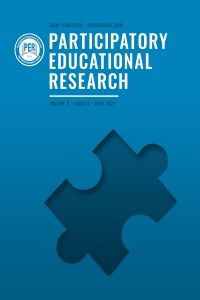Research Article
Year 2022,
Volume: 9 Issue: 2, 313 - 324, 01.03.2022
Abstract
References
- Sadioğlu, Ö. ve Bilgin, A. (2008). İlköğretim öğrencilerinin eleştirel okuma becerileri ile cinsiyet ve anne-baba eğitim durumu arasındaki ilişki [The relationship between primary school students' critical reading skills and gender and educational status of parents]. İlköğretim Online, 7(3), 814-822.
Examination of the Relationship Between Creative Thinking Skills and Comprehension Skills of Middle School Students
Abstract
The relationship between language and thinking and the effect of these two skills on each other is accepted by field experts, but the level of the relationship is still a matter of debate. In this research, some part of the relationship between language and thought has been dwelled upon. The aim of the research is to determine the 7th grade students' reading, listening comprehension and creative thinking levels; to determine the relationship between reading comprehension and creative thinking and listening comprehension and creative thinking skills. The data of the study, which is a descriptive field study in the relational screening model, was collected from a total of 380 7th grade students, 199 women and 181 men, in the 2019-2020 academic year. As a data collection tool within the scope of the research; "Reading Comprehension Achievement Test", "Listening Comprehension Achievement Test" and "Torrance Creative Thinking Test Verbal A Form" were used. The analysis of the data was done by pearson correlation analysis. Secondary school students' reading comprehension levels are medium, and their listening comprehension levels are medium. As a result of the correlation analysis, most significant correlation is between reading comprehension and listening comprehension, and the least significant correlation is between reading comprehension and fluency, which is a sub-dimension of creativity. There is a positive, statistically significant relationship between the listening comprehension and creative thinking skill scores. There is a positive and statistically highly significant relationship between reading comprehension and listening comprehension skill scores. There is a positive, significant relationship between reading comprehension and creative thinking skill skills. All of the relationships are statistically significant.
References
- Sadioğlu, Ö. ve Bilgin, A. (2008). İlköğretim öğrencilerinin eleştirel okuma becerileri ile cinsiyet ve anne-baba eğitim durumu arasındaki ilişki [The relationship between primary school students' critical reading skills and gender and educational status of parents]. İlköğretim Online, 7(3), 814-822.
There are 1 citations in total.
Details
| Primary Language | English |
|---|---|
| Subjects | Studies on Education |
| Journal Section | Research Articles |
| Authors | |
| Publication Date | March 1, 2022 |
| Acceptance Date | August 13, 2021 |
| Published in Issue | Year 2022 Volume: 9 Issue: 2 |



